|
|
|
|
|
|
Wahi Pana
means celebrated places. These are areas that have significance
for the people who live here. In this section we will visit
a few of the celebrated places at Nawiliwili Bay. We also meet
our historical guides, who share their stories and knowledge
about Nawiliwili throughout 'Ainakumuwai: Ahupua'a of Nawiliwili
Bay. |
|
|
|
Hobey Goodale grew up at Kalapaki in the 1930's. At the age
of 18, he was in charge of the last sugar harvest at Kipu.
Hobey's knowledge about the ahupua'a of Nawiliwili Bay is
unique. His knowledge is based on a love of the land, its
people, and Hobey's active participation in their history.
Mahalo, Hobey.
To the right, Hobey from his polo playing days at Kipu.
|
|
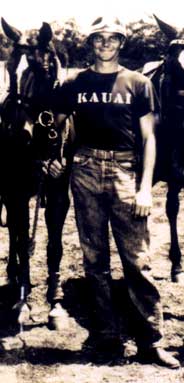 |
|
|
|
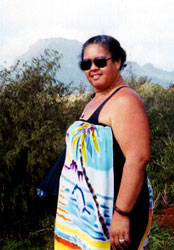 |
|
Cheryl Lovell-Obatake is a media star. You have seen her on
TV - testifying on behalf of the land, the water, and Hawaiian
culture. Cheryl's roots are deep inside the ahupua'a of Nawiliwili
Bay. Cheryl shares her stories and mana'o (thoughts)
from a solid base of experience, knowledge, and aloha.
Mahalo, Cheryl.
|
|
|
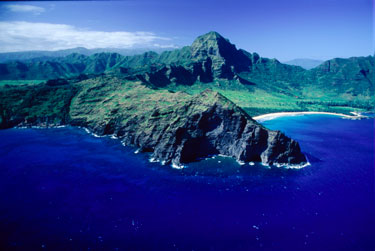
|
|
Ha'upu is a dominant feature of Nawiliwili Bay. Like
an old friend, Ha'upu greets us as we approach from the ocean.
|
|
|
|
Photo by David Boynton |
|
|
|
|
|
|
As we travel around Nawiliwili Bay, Ha'upu is visible from every
ahupua'a. It is a southern boundary for the ahupua'a of Ha'iku
and Kipu. |
|
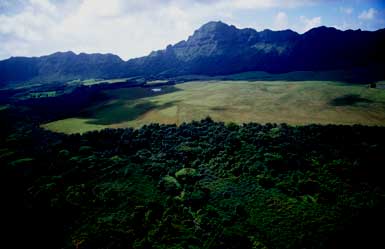 |
|
|
|
Photo by David Boynton, pilot Casey
Riemer of Jack Harter Helicopters. |
|
|
|
|
|
|
|
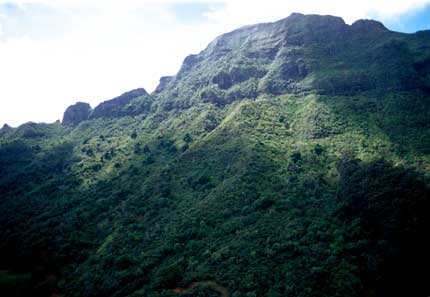 |
|
Ha'upu is both a ridge and peak. It was also called the Hoary
Head. Although Ha'upu means recollection, its name is now associated
with a giant of the same name who lived there. (Wichman) |
|
Photo by David Boynton, pilot Casey
Riemer of Jack Harter Helicopters. |
|
|
|
|
Ha'upu mauna
kilohana i ka la'i.
Ha'upu, a mountain outstanding in the calm.
Said of a person of outstanding achievement, also used in
praise of Ha'upu.
Olelo No'eau #496
Ka'i ka pua'a
i luna o Ha'upu, e ua ana.
When the pigs move around the summit of Ha'upu,
it is going to rain.
Referring to puffy pig clouds around Ha'upu as a sign
of rain.
Oleleo No'eau #1395
Ka 'ohu wanana ua
of Ha'upu
The mist of Ha'upu that
foretells rain.
Olelo No'eau#1513
|
|
| Kilohana
is another celebrated place of Nawiliwili Bay. The ahupua'a
of Kalapaki, Nawiliwili, Niumalu, and part of Ha'iku begin on
the slopes of this small shield volcano. Kilohana means look
out point, or the best, superior. It is indeed a superior place
to look out over Nawiliwili. To the right, the view from Kilohana,
with the collapse crater at its summit visible in the foreground. |
|
|
|
|
|
|
|
Photo by David Boynton, pilot Casey
Riemer of Jack Harter Helicopters. |
|
|
|
|
|
|
|
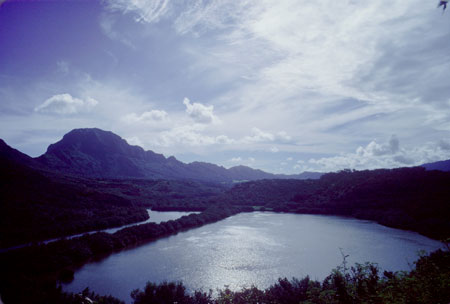 |
|
Alekoko (The Menehune Fishpond), is a major reminder
of Hawaiian culture in this area. Frederick Wichman says there
used to be five other fishponds on this side of the river, with
three more on the Ha'upu side. |
|
Photo by David Boynton
|
|
|
|
|
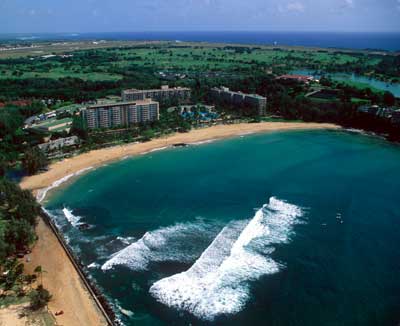 |
|
Kalapaki Bay is a favorite gathering place
for locals and tourists. It is the ocean border of the ahupua'a
of Kalapaki |
|
|
|
Photo by David Boynton, pilot Casey
Riemer of Jack Harter Helicopters. |
|
|
|
|
|
|
Pau kini is the rock where the
kahuna-nui (head priest) of Kuhiau heiau
(temple) lived. It survived the harbor construction, and remains
to this day a celebrated place at Kalapaki Bay. (Wichman)
Cheryl says, "My uncle used to sit on Pau kini.
If you look closely, the rock is in a formation of a chair,
and that is where he could spot manini (surgeonfish),
mullet."
|
|
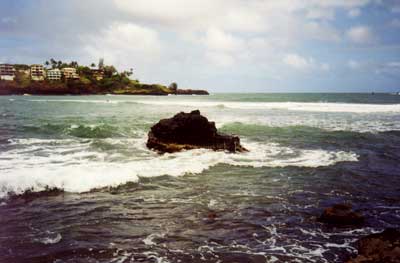 |
|
|
|
|
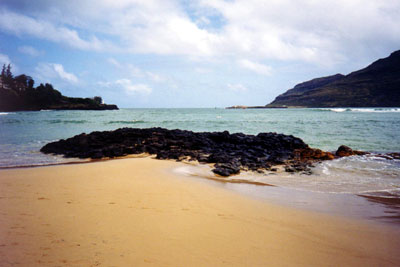 |
|
Mokuweo is the second famous rock at Kalapaki.
Cheryl tells the story of old man Aiu - " He used to
feed the fish off that rock, a lot of sharks came in. He had
his own old ways of giving back to the fish, feeding the fish,
making sure they come - and it was all for the people, for
everybody in the community."
|
|
|
These are but some of the celebrated
places of Nawiliwili Bay. You may have your own places to celebrate.
In order to talk about the changes leading to the way Nawiliwili
Bay is today, we need to begin by describing the
natural history of this area, or what it was like before
Hawaiian voyagers arrived. |
|
|
|
|
|
|
|
|

